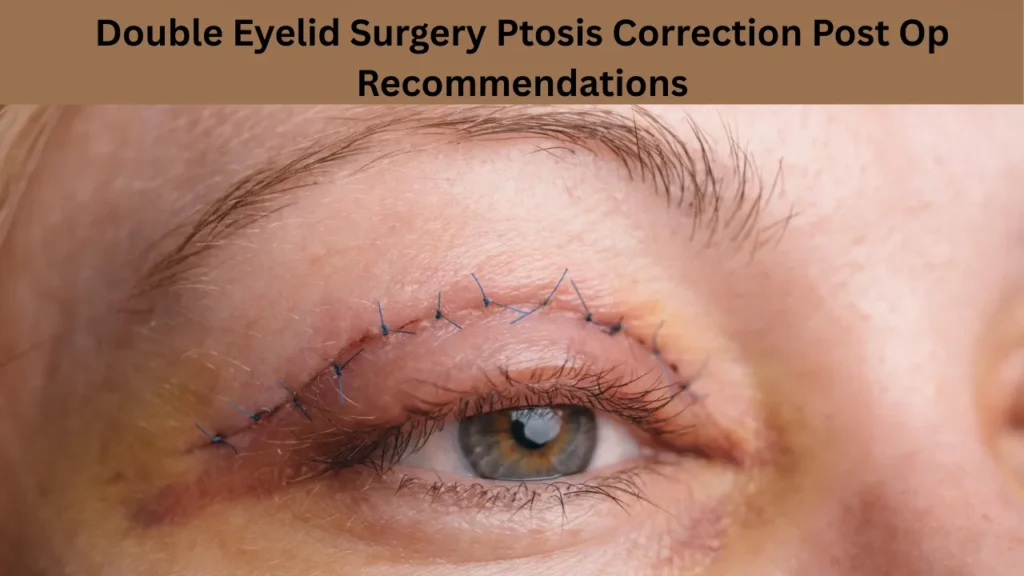Double eyelid surgery and ptosis correction are common procedures used to improve eye appearance and eyelid function. While the surgery itself is a major step, what follows afterward is equally important. Proper care during recovery ensures the best results and avoids complications. This guide will walk you through the most essential double eyelid surgery ptosis correction post op recommendations to help you heal smoothly and confidently.
Also Read: cenpok.com
What to Expect After Surgery
Right after surgery, it’s normal to experience swelling, mild bruising, and sensitivity around the eyes. You may also notice blurred vision or a tight feeling in the eyelids. These reactions are temporary and part of the healing process. Your surgeon will apply a light bandage and might recommend resting for the first 24–48 hours. This early phase is when the body starts healing, and your actions now will impact how well and how quickly your eyes recover.
Also Read: 5StarsStocks.com Blue Chip: Safe & Smart Investing Guide
Handling Swelling and Bruising
One of the first signs of healing is swelling, which can be reduced with proper care. Cold compresses are your best friend during the first few days. Apply a cold compress for 10 to 15 minutes every hour on the first day and then three to four times daily for the next two to three days. This method reduces inflammation and helps blood vessels contract.
Keep your head elevated while sleeping or resting. Use two or three pillows or a reclining chair to allow fluids to drain properly and reduce puffiness. This position also makes breathing easier and keeps your eyes protected while you sleep.
Here’s a simple breakdown to follow:
| Time Frame | Action Steps |
|---|---|
| Day 1 | Cold compress every hour, head elevated |
| Days 2–3 | Compress 3–4 times a day, continue resting |
| Week 1 | Stitches may be removed, light walking allowed |
| Week 2–3 | Swelling and bruising decrease significantly |
| Month 2–3 | Final results start to show |
Also Read: www.goodmooddotcom.com Cruising Category: Guide
Cleaning and Caring for Incisions
Keeping your eyelids clean after surgery is critical. Gently clean the incision area with sterile saline or as directed by your doctor. Never scrub the area, and always wash your hands before touching your face. After cleaning, apply the prescribed antibiotic ointment to prevent infection and speed up healing.
Make sure your eyelids remain dry during showers for at least the first five days. You can wash your hair with your head tilted backward to avoid water touching your eyes. Use a soft towel to pat your face dry—don’t rub.
Also Read: Coyyn.com Rare Coins: Trusted for Collectors & Investors
Eye Protection and Medication Tips
Doctors usually prescribe lubricating eye drops or ointments after surgery to prevent dryness. Use them every four to six hours or as instructed. These drops reduce discomfort and help your eyes stay moist during healing.
Avoid painkillers like ibuprofen or aspirin, as they increase bleeding risks. If you need pain relief, acetaminophen (Tylenol) is the safest option. Do not self-medicate; always follow your surgeon’s instructions. These guidelines are an essential part of double eyelid surgery ptosis correction post op recommendations to ensure your safety and comfort.
Also Read: MyWebInsurance.com Renters Insurance: Explained Simply
Managing Activity and Movement
Take it easy. Your body needs time to heal, and the first 7–10 days are crucial. Rest as much as possible. Avoid lifting heavy objects, bending over, or engaging in intense activities. Even tasks like vacuuming or grocery shopping can put pressure on your healing eyelids.
Light walking is fine after the third day, and it helps improve blood flow, which supports healing. However, avoid direct sunlight, dusty places, and screens for long periods. Protecting your eyes helps prevent irritation and infection.
Key Signs You Should Not Ignore
While most recoveries go smoothly, you should be aware of symptoms that need medical attention. The following are warning signs that could signal complications:
- Increased redness or swelling around the eyes
- Sudden, sharp pain or throbbing
- Yellow or green discharge from the incision
- Blurred or double vision that worsens
- Fever or chills
If you notice any of these signs, contact your doctor right away. Following the right double eyelid surgery ptosis correction post op recommendations means staying alert to any changes in your recovery.
Wearing Makeup and Contact Lenses
It’s important not to wear any makeup or apply creams near your eyes for at least two weeks. These products can irritate your incisions or introduce bacteria that may cause infections. Once your surgeon gives the green light, usually after 14 days, you can gradually reintroduce makeup.
Contact lenses should also be avoided during the first two weeks. They can put pressure on your eyelids and slow healing. Stick to glasses until your surgeon confirms it’s safe to switch back.
Sleeping Position and Eye Care
Sleeping on your back is one of the best things you can do during recovery. It keeps pressure off your eyes and ensures swelling stays under control. Avoid rolling onto your side or stomach during the night.
Using sunglasses outdoors is another smart tip. They protect your sensitive eyes from dust, wind, and harmful UV rays. Sunlight can darken scars and delay healing, so wear protective lenses and apply sunscreen around the eyes once your incisions close fully.
Importance of Follow-Up Visits
Your follow-up appointments are not optional—they’re a critical part of your recovery journey. Most surgeons schedule a check-up within five to seven days after surgery to monitor healing and remove stitches if needed.
These appointments give your doctor the chance to evaluate the progress and adjust your care plan. They can also answer questions and provide reassurance that your results are on track. Double eyelid surgery ptosis correction post op recommendations always include attending all scheduled visits for the best outcomes.
Timeline for Recovery
Every patient heals differently, but here is a typical recovery schedule:
| Week/Month | Recovery Stage |
|---|---|
| Week 1 | Swelling peaks then starts to improve |
| Week 2–3 | Bruising fades, most stitches removed |
| Week 4 | Light makeup and daily activities allowed |
| Month 2–3 | Final eyelid shape and improved vision appear |
| Month 6+ | Complete healing and permanent results achieved |
Being patient during this time is important. Rushing into normal life too early can risk your results.
Nutrition and Hydration for Faster Healing
Proper nutrition plays a critical role in healing. Your body uses nutrients to rebuild tissue, reduce inflammation, and fight infection.
Here’s what you should focus on:
- High-protein foods: Eggs, tofu, chicken, and fish support tissue repair.
- Vitamin C: Found in oranges, strawberries, and bell peppers, it boosts collagen production.
- Zinc-rich foods: Almonds, whole grains, and legumes help wounds close faster.
- Hydration: Drinking 8–10 glasses of water daily keeps your skin and eyes hydrated.
Avoid salty foods during the first week, as salt increases water retention and can worsen swelling. It’s also best to limit caffeine and avoid alcohol altogether during recovery.
Why Post-Op Care Makes a Difference
Your surgery might be over, but how you care for your eyes afterward will shape your final outcome. The most trusted double eyelid surgery ptosis correction post op recommendations stress hygiene, rest, gentle care, and regular checkups.
Taking shortcuts or ignoring instructions could lead to poor results or unwanted scars. But by staying consistent with your care, you increase your chances of beautiful, natural-looking eyelids and improved vision.
Final Thoughts
Recovering from surgery is a journey, and knowing the right double eyelid surgery ptosis correction post op recommendations makes a big difference. Your actions, your rest, and your care all play a role in healing. Always follow your surgeon’s advice, listen to your body, and don’t hesitate to ask questions.
In the end, a little patience goes a long way. With the right steps, your eyes will look and feel better than ever.



